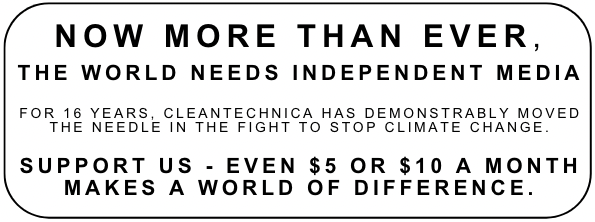Saving The Planet, One Landfill At A Time
 Sign up for CleanTechnica's Weekly Substack for Zach and Scott's in-depth analyses and high level summaries, sign up for our daily newsletter, and/or follow us on Google News!
Sign up for CleanTechnica's Weekly Substack for Zach and Scott's in-depth analyses and high level summaries, sign up for our daily newsletter, and/or follow us on Google News!
“Where there’s muck, there’s money,” my old Yorkshire grandmother used to say. I could paraphrase that after my recent visit to LGI at Banyo in Queensland. Their motto, “saving the planet, one landfill at a time,” pretty much sums up their mission. They tap and capture the methane produced by old landfills, tips, and dumps and either mitigate the environmental impacts by burning it onsite or even better by feeding it into a gigantic engine and using it to create dispatchable electricity. They are helping to expedite the transition to renewables.

Katrina Nelson and Jarryd Doran were most generous with their time, discussing the business and also showing us their vertically integrated workshop where they build and service their machinery. Both are obviously committed to a low-carbon future, as they drive Tesla Model 3s and their CEO drives an electric Mini. Tess enjoyed the company in the carpark.
There will be some of you who will object that burning methane is not the best. I would agree, but it is better than allowing the methane unabated access to our atmosphere. Burning methane (or combusting) converts it into carbon dioxide. This is 28 times less damaging than the methane itself (some say up to 80 times). Not a perfect solution, but the best we can do in some situations. On larger landfills, where it is commercially viable, the methane is burnt in a modified internal combustion engine attached to an alternator to generate dispatchable energy. Future plans include hybrid systems of landfill methane, with internal combustion engine generators, batteries, and solar.
The landfill itself can also be seen as a bio battery. It has some storage capability. Methane production varies with the weather and is higher in warmer weather. This leads to a rethink — it isn’t just an old tip, it is now an energy precinct, less of a liability and more of an asset. Some councils may opt to use the energy themselves for behind-the-meter applications — like running their wastewater treatment plant. This will happen in Toowoomba this year when LGI upgrades its biogas flaring project to a power project.
Remember, the methane was already there, created by our history of waste management, and it will seep out anyway and cause havoc. This way at least we create a useful product and mitigate the harmful effects of the biogas. LGI uses existing technology to create a solution to an existing problem, while we can change our ways to create less waste and increase our re-use and recycling habits to divert more waste from landfills.
Apparently, there is a whole world of underground methane generation that I was unaware of. Brisbane city council alone manages 150 legacy landfill sites. Many of these sites generate biogas, which if not captured seeps into the atmosphere. LGI actively works with councils to manage this biogas and turn it into a useful product. It takes time.
One example is the Toowoomba landfill site where LGI installed a biogas extraction system which it has been operating and monitoring for over 12 months to see if investing the millions of dollars in a generator would be viable. The biogas extraction infrastructure is in place, the quantity of the biogas production is being measured. The biogas is currently being flared. Biogas is approximately 50% methane and 40% carbon dioxide. The other 10% is a whole range of gases, some which cause a lot of wear and tear on the generators.
The future for LGI’s Gladstone biogas generation project includes installing solar generation, batteries, and an EV charging station. Imagine filling up your EV with electricity generated by biogas from a landfill? That’s environmentally friendly. And this will be remotely managed through a Starlink connection — on order from SpaceX as we speak.
All sites are monitored in real time and shown on the display in the head office. When required, a generator can be turned on, via a mobile app, and be producing within 5 minutes. LGI can currently produce 85 GWh of electricity per year, across Queensland, New South Wales, and the ACT.

Carbon abatement by combusting the biogas with a flare or in a power station creates a revenue stream for LGI from carbon credits under the scheme set up by the federal government back in 2015. The Clean Energy Regulator (CER) also certifies displacement of fossil fuels by issuing Large Scale Generation Certificates (LGCs) when LGI produces electricity. These certificates can then be sold. LGI is also able to sell the electricity it creates back to the grid and to customers behind the meter. This revenue means that LGI can offer a low- or no-cost solution to local councils that may be dealing with long-term historic issues. A tip may be closed, but it will be generating methane for decades to come. For example, LGI operates on the Willawong landfill, which has been closed for 20 years and still produces enough biogas to support a power generation project.
LGI can react nimbly to local council requirements because it is vertically integrated with its own equipment to manufacture and design solutions to landfill needs.
LGI is saving the planet one landfill at time, using existing, proven technology to create a viable business out of society’s waste products.

Have a tip for CleanTechnica? Want to advertise? Want to suggest a guest for our CleanTech Talk podcast? Contact us here.
Sign up for our daily newsletter for 15 new cleantech stories a day. Or sign up for our weekly one if daily is too frequent.
CleanTechnica uses affiliate links. See our policy here.
CleanTechnica's Comment Policy
